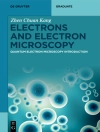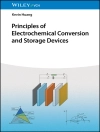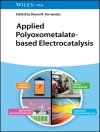Basic Electrochemistry for Biotechnology
Understand the basics of a thriving interdisciplinary research field
Microbial electrochemistry is a subfield of bioelectrochemistry which concerns interactions between microbial organisms and electrically active surfaces such as electrodes. Its growth as a subject of research has been rapid in recent years, and its technological applications are many, particularly as the race to find sustainable organic energy sources accelerates.
Basic Electrochemistry for Biotechnology offers an accessible overview of this interdisciplinary subject and its potential applications. Moving smoothly from the general to the specific, it offers both fundamental principles and some of the most relevant specific examples, such as biofilm electrodes, microbial fuel cells or microbial electrosynthesis cells, making it the ideal choice for building a working knowledge of this exciting new field. Its solid foundation of microbial electrochemical technologies also serves as a starting point for a wide range of applied research areas.
Basic Electrochemistry for Biotechnology readers will also find:
- Carefully designed artistic illustrations
- Hands-on exercises throughout to facilitate entry into laboratory work
- Numerous illustrative examples and calculations designed to demonstrate and reinforce key principles
Basic Electrochemistry for Biotechnology is the perfect point of entry into this growing field for both students and researchers.
Inhoudsopgave
List of Figures ix
List of Boxes xxi
Preface xxiii
1 A Reader’s Guide to Basic Electrochemistry for Biotechnology 1
2 A Basic Introduction to Microbial Electrochemical Technologies 3
2.1 Introduction to Microbial Energy Conversion and Microbial Electrochemical Technologies 3
2.1.1 Microbial Conversions 3
2.1.2 Microbial Fuel Cells and Microbial Electrolysis Cells 5
2.2 Electroactive Microorganisms and Mechanisms of Extracellular Electron Transfer 7
2.2.1 Extracellular Electron Transfer Mechanisms: The Role Models of Electroactive Microorganisms 7
2.2.2 A Snapshot on Electroactive Microorganisms 8
2.3 Energetics: The Redox Tower and a Water Analogy 9
2.4 Wastewater Characteristics 13
2.4.1 Physical Wastewater Characteristics 14
2.4.2 Chemical Wastewater Characteristics 14
2.4.3 Organic Constituents in Wastewater 15
2.4.4 Biological Wastewater Characteristics 16
2.5 Microbial Electrochemical Technologies: Systems and Design 17
2.5.1 Main Components and Design 17
2.5.2 Operational Modes 18
2.5.3 Electrodes and Current Collectors 19
2.5.4 Ionic Charge Transport and Membranes 21
2.5.5 Lab Measurements and Criteria for Normalization 22
2.6 Short Alert on Terminology 23
Questions 24
References 25
3 Electrochemical Potential, Electrode Potential, and the Need for Reference Electrodes 27
3.1 Introduction to Electrochemical Potentials 27
3.1.1 A Physical-Chemical Approach Toward Electrochemical Potentials 28
3.2 Electrodes and Electrode Reactions 36
3.2.1 Definition of Electrodes and Electrochemical Half-Cells 36
3.2.2 Scientific Notation of Electrochemical Cells 37
3.2.3 Types of Electrodes 38
3.3 The Relative Electrode Potential and the Need for Reference Electrodes 40
3.3.1 Point of Reference for Electrode Potentials 42
3.3.2 Reference Electrodes Explained via the Water Analogy 45
Questions 46
References 47
4 Reaction Equations and Thermodynamics of Electrochemical Reactions 49
4.1 Introduction to Oxidation and Reduction Reactions and Thermodynamic Limits 49
4.2 How to Write and Balance Reaction Equations of (Bio)electrochemical Reactions 50
4.2.1 Reaction Equations for the Hydrogen Fuel Cell 51
4.2.2 Reaction Equations for a Microbial Electrolysis Cell 53
4.3 Thermodynamics of Electrochemical Conversions 57
4.3.1 Calculations Assuming Standard Conditions 57
4.3.2 The Effect of Actual Concentrations on Gibbs Free Energy Change 62
4.3.3 The Effect of Temperature on Gibbs Free Energy Change 65
Questions 68
References 68
5 Static Electrochemical Methods 69
5.1 Introduction to Static Electrochemical Methods 69
5.2 What Is a Three-Electrode Arrangement, a Potentiostat or Power Supply, and for What Are They Needed? 70
5.3 The Electrochemical Double Layer and Capacitive Current 74
5.4 Potentiometry, Amperometry, Coulometry, and Constant Current Measurements 78
5.5 Chronoamperometry 82
Questions 87
References 88
6 Electrochemical Kinetics 89
6.1 Introduction to Electrochemical Kinetics 89
6.2 Basics of Electrochemical Kinetics 90
6.3 Electrochemical Reversibility 91
6.4 Overpotentials 94
6.5 The Overpotential Due to Mass Transfer 98
6.6 Potential-Current Plots and Electrode Kinetics 101
6.7 The Butler–Volmer Equation 103
6.8 Tafel Equation and Tafel Plots 106
6.9 Electrocatalysis 108
Questions 113
References 114
7 Dynamic Electrochemical Methods 115
7.1 Introduction to Electrochemical Methods with Changing Electrode Potential 115
7.2 Voltammetry 117
7.3 Performing Dynamic Electrochemical Methods Using Potentiostats: Discriminating Capacitive and Faradaic Current 117
7.3.1 The Principles of Linear Sweep Voltammetry 120
7.4 Cyclic Voltammetry 123
7.4.1 General Considerations and Basic Data Analysis 123
7.4.2 Studying Biofilm Electrodes Using Cyclic Voltammetry 131
7.4.3 Experimental Design and Limits of Information from Data 134
7.5 Redox-Active Components in Microorganisms 136
7.6 Acquisition of Polarization and Power Curves Using Stepwise Chronoamperometry and Chronopotentiometry 139
7.7 Acquisition of Polarization Curves Using External Resistance 145
7.8 Electrochemical Impedance Spectroscopy 147
Questions 152
References 152
8 Electrochemical Analysis of Reactors 155
8.1 Introduction to Characterization of Microbial Electrochemical Cells 155
8.2 Mass and Electron Balances and Efficiency of Conversions 157
8.2.1 Establishing Balances for Mass and Electrons 157
8.2.2 Removal Efficiency 158
8.2.3 Coulombic Efficiency 159
8.3 Polarization and Power Curves: Analysis of Measured Data 161
8.4 Internal Resistance and Potential Losses 168
8.5 Energy Efficiency and Voltage Efficiency 174
8.6 Ionic Current and Transport Numbers 176
8.6.1 Ionic Current for the Specific Removal and Recovery of Ions 176
8.6.2 Ionic Current and p H Gradients 177
Questions 178
References 179
9 Seizing the Beauty and Acknowledging the Complexity of Basic Electrochemistry for Biotechnology 181
Appendix A Abbreviations 185
Appendix B Symbols with Definition and Unit 187
Appendix C Solutions to Exercises 193
Appendix D Tabulated Values 217
Index 219
Over de auteur
Falk Harnisch, Ph D, is a group leader at the Heimholtz Centre for Environmental Research and a Professor at Leipzig University, Leipzig, Germany. He has published extensively on microbiology and electrochemistry, and his awards and honors include the Helmholtz Young Investigators Group award as well as serving as President of the International Society of Microbial Electrochemistry and Technology (ISMET) 2021-2023.
Tom Sleutels, Ph D, is a researcher at the University of Groningen and Wetsus, European Centre of Excellence for Sustainable Water Technology in the Netherlands. His research focuses on microorganisms and their role in renewable energy and resource recovery processes.
Annemiek ter Heijne, Ph D, is Chair and Professor of Environmental Technology at Wageningen University & Research, The Netherlands. She is an environmental engineer studying different aspects and applications of microbial electrochemical technologies, and served as President of ISMET 2019-2021.












